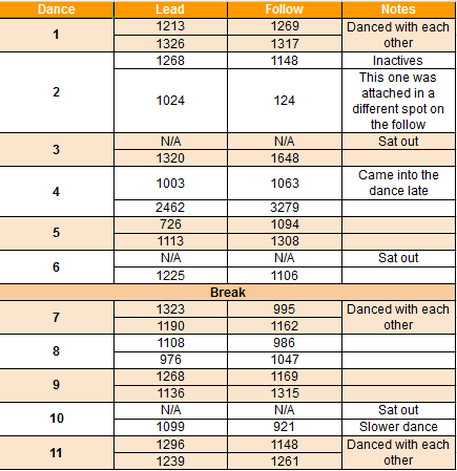Which got me (as someone who typically dances the follow's part) thinking: does the follow actually exert themselves more in a typical dance? There are people who object to my use of "lead" and "follow" on this blog because they believe it to be an entirely equal dance form for which those labels are (or should be) meaningless. Meanwhile, in a ladies' chain (which is so much more common than a men's chain that even a decent chunk of experienced dancers don't know how to pull a men's chain off smoothly, at least around these parts), someone dancing the lady's role and dancing without flourishes crosses the set and takes at least four medium-to-large steps around the outside of a circle, whereas someone dancing the gent's role will take maybe four small steps backwards to help the lady around the courtesy turn.
So Steve and I gathered up some (cheap) pedometers and sought to calibrate them on Sunday.
We are making the following assumptions:
- The number of steps someone takes is reflective of the amount of physical exertion someone expends in a dance;
- The average of these numbers will give us a general sense of which "role" physically exerts itself more overall;
- The pedometers are relatively accurate;*
- Pedometers were reset to zero after every dance's walkthrough, but before the actual dance started so that we weren't counting mistakes made in the walkthrough in our step counts;
- Dances take place over roughly the same amount of time;
- We are using Glen Echo as our model; we are aware that most dance communities' local dances do not have 2 to 5 long sets of over 15 minor sets each, but that's our local sample so we're using it (acknowledging that this may make a difference too, especially with dances where your inactive/active position matters);
- The differences amongst dancers, bands, and callers (fast/slow, chestnuts or more modern dances) will normalize over several weeks' worth of data and a varied list of partners (and combining Steve's partners with mine, as we tend to dance in different lines when not dancing together).
* some of the data points imply that perhaps this is not true, or that we should be more careful in matching up pedometers amongst partner pairs (or find a better way to calibrate them). But this is why we collect preliminary data ahead of time.
What follows is our raw data from Sunday:
Glen Echo, MD, Sunday, December 16, 2012
Band: Perpetual e-Motion
Caller: Bev Bernbaum
So we're opening up our process and our data to other minds as well. How else can we improve our experiment when we jump in for real? Anyone care to venture any hypotheses for when we get this off the ground?
Special thanks to Will, Jesse, Emma, Ron, Leslie, Abby, Miriam, Steve B., Eireann, Eric, Bethany, & Sophia for your help gathering preliminary data!
To be continued....

